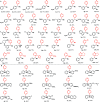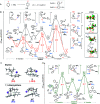Organoborohydride-catalyzed Chichibabin-type C4-position alkylation of pyridines with alkenes assisted by organoboranes
- PMID: 34094401
- PMCID: PMC8162492
- DOI: 10.1039/d0sc04808a
Organoborohydride-catalyzed Chichibabin-type C4-position alkylation of pyridines with alkenes assisted by organoboranes
Abstract
The first NaBEt3H-catalyzed intermolecular Chichibabin-type alkylation of pyridine and its derivatives with alkenes as the latent nucleophiles is presented with the assistance of BEt3, and a series of branched C4-alkylation pyridines, even highly congested all-carbon quaternary center-containing triarylmethanes can be obtained in a regiospecific manner. Therefore, the conventional reliance on high cost and low availability transition metal catalysts, prior formation of N-activated pyridines, organometallic reagents, and extra oxidation operation for the construction of a C-C bond at the C4-position of the pyridines in previous methods are not required. The corresponding mechanism and the key roles of the organoborane were elaborated by the combination of H/D scrambling experiments, 11B NMR studies, intermediate trapping experiments and computational studies. This straightforward and mechanistically distinct organocatalytic technology not only opens a new door for the classical but still far less well-developed Chichibabin-type reaction, but also sets up a new platform for the development of novel C-C bond-forming methods.
This journal is © The Royal Society of Chemistry.
Conflict of interest statement
There are no conflicts to declare.
Figures






Similar articles
-
Transition-metal-catalyzed asymmetric allylic dearomatization reactions.Acc Chem Res. 2014 Aug 19;47(8):2558-73. doi: 10.1021/ar500167f. Epub 2014 Jun 18. Acc Chem Res. 2014. PMID: 24940612
-
Rare-earth-catalyzed C-H bond addition of pyridines to olefins.J Am Chem Soc. 2011 Nov 16;133(45):18086-9. doi: 10.1021/ja208129t. Epub 2011 Oct 20. J Am Chem Soc. 2011. PMID: 21999322
-
Cobalt-Catalyzed 2-(1-Methylhydrazinyl)pyridine-Assisted C-H Alkylation/Annulation: Mechanistic Insights and Rapid Access to Cyclopenta[c]isoquinolinone Derivatives.J Org Chem. 2021 Nov 5;86(21):14915-14927. doi: 10.1021/acs.joc.1c01658. Epub 2021 Sep 27. J Org Chem. 2021. PMID: 34570982
-
Aleksei Yevgen'evich Chichibabin (1871-1945): A Century of Pyridine Chemistry.Angew Chem Int Ed Engl. 2017 Aug 7;56(33):9660-9668. doi: 10.1002/anie.201611724. Epub 2017 Jun 12. Angew Chem Int Ed Engl. 2017. PMID: 28605569 Review.
-
Metal-catalyzed silylation of sp3C-H bonds.Chem Soc Rev. 2021 Apr 26;50(8):5062-5085. doi: 10.1039/d0cs01392g. Chem Soc Rev. 2021. PMID: 33629997 Review.
Cited by
-
Functionalization of Pyridines at the C4 Position via Metalation and Capture.Angew Chem Int Ed Engl. 2025 Mar 24;64(13):e202424172. doi: 10.1002/anie.202424172. Epub 2025 Jan 16. Angew Chem Int Ed Engl. 2025. PMID: 39752240 Free PMC article.
-
Reaction strategies for the meta-selective functionalization of pyridine through dearomatization.Mol Divers. 2025 Feb;29(1):849-869. doi: 10.1007/s11030-024-10861-5. Epub 2024 Apr 22. Mol Divers. 2025. PMID: 38647989 Review.
-
Pyridine C(sp2)-H bond functionalization under transition-metal and rare earth metal catalysis.Beilstein J Org Chem. 2023 Jun 12;19:820-863. doi: 10.3762/bjoc.19.62. eCollection 2023. Beilstein J Org Chem. 2023. PMID: 37346497 Free PMC article. Review.
-
Practical and Regioselective Synthesis of C-4-Alkylated Pyridines.J Am Chem Soc. 2021 Aug 11;143(31):11927-11933. doi: 10.1021/jacs.1c05278. Epub 2021 Jul 28. J Am Chem Soc. 2021. PMID: 34318659 Free PMC article.
References
-
- Daly J. W., Garraffo H. M. and Spande T. F., in Alkaloids: Chemical and Biological Perspectives, ed. W. W. Pelletier, Elsevier, New York, 1999, vol. 13, pp. 92–104
- Vitaku E. Smith D. T. Njardarson J. T. J. Med. Chem. 2014;57:10257–10274. doi: 10.1021/jm501100b. - DOI - PubMed
- Skrypink Y. G. Doroshenko T. F. Mater. Sci. 1996;32:537–544. doi: 10.1007/BF02539063. - DOI
- Leclerc N. Sanaur S. Galmiche L. Mathevet F. Attias A.-J. Fave J.-L. Roussel J. Hapiot P. Lemaître N. Geffroy B. Chem. Mater. 2005;17:502–513. doi: 10.1021/cm040358k. - DOI
-
-
For leading reviews, see:
- Snieckus V. Chem. Rev. 1990;90:879–933. doi: 10.1021/cr00104a001. - DOI
- Gros P. Fort Y. Eur. J. Org. Chem. 2002:3375–3383. doi: 10.1002/1099-0690(200210)2002:20<3375::AID-EJOC3375>3.0.CO;2-X. - DOI
- Schlosser M. Mongin F. Chem. Soc. Rev. 2007;36:1161–1172. doi: 10.1039/B706241A. - DOI - PubMed
- Gros P. C. Fort Y. Eur. J. Org. Chem. 2009:4199–4209. doi: 10.1002/ejoc.200900324. - DOI
- Ahamed M. Todd M. H. Eur. J. Org. Chem. 2010:5935–5942. doi: 10.1002/ejoc.201000877. - DOI
- Nakao Y. Synthesis. 2011:3209–3219. doi: 10.1055/s-0030-1260212. - DOI
- Zhuo C.-X. Zhang W. You S.-L. Angew. Chem., Int. Ed. 2012;51:12662–12686. doi: 10.1002/anie.201204822. - DOI - PubMed
- Bull J. A. Mousseau J. J. Pelletier G. Charette A. B. Chem. Rev. 2012;112:2642–2713. doi: 10.1021/cr200251d. - DOI - PubMed
- Ding Q. Zhou X. Fan R. Org. Biomol. Chem. 2014;12:4807–4815. doi: 10.1039/C4OB00371C. - DOI - PubMed
- Murakami K. Yamada S. Kaneda T. Itami K. Chem. Rev. 2017;117:9302–9332. doi: 10.1021/acs.chemrev.7b00021. - DOI - PubMed
-
-
-
For recent reviews on the Minisci reaction, see:
- Duncton M. A. J. MedChemComm. 2011;2:1135–1161. doi: 10.1039/C1MD00134E. - DOI
- Proctor R. S. J. Phipps R. J. Angew. Chem., Int. Ed. 2019;58:13666–13699. doi: 10.1002/anie.201900977. - DOI - PubMed
-
; For selected examples, see:
- Minisci F. Bernardi R. Bertini F. Galli R. Perchinummo M. Tetrahedron. 1971;27:3575–3579. doi: 10.1016/S0040-4020(01)97768-3. - DOI
- Fujiwara Y. Domingo V. Seiple I. B. Gianatassio R. Bel M. D. Baran P. S. J. Am. Chem. Soc. 2011;133:3292–3295. doi: 10.1021/ja111152z. - DOI - PMC - PubMed
- Molander G. A. Colombel V. Braz V. A. Org. Lett. 2011;13:1852–1855. doi: 10.1021/ol2003572. - DOI - PMC - PubMed
- Nagib D. A. MacMillan D. W. C. Nature. 2011;480:224–228. doi: 10.1038/nature10647. - DOI - PMC - PubMed
- Fujiwara Y. Dixon J. A. Hara F. O. Funder E. D. Dixon D. D. Rodriguez R. A. Baxter R. D. Herle B. Sach N. Collins M. R. Ishihara Y. Baran P. S. Nature. 2012;492:95–99. doi: 10.1038/nature11680. - DOI - PMC - PubMed
- Antonchick A. P. Burgmann L. Angew. Chem., Int. Ed. 2013;52:3267–3271. doi: 10.1002/anie.201209584. - DOI - PubMed
- Garza-Sanchez R. A. Tlahuext-Aca A. Tavakoli G. Glorious F. ACS Catal. 2017;7:4057–4061. doi: 10.1021/acscatal.7b01133. - DOI
- Cheng W.-M. Shang R. Fu Y. ACS Catal. 2017;7:907–911. doi: 10.1021/acscatal.6b03215. - DOI
- Proctor R. S. J. Davis H. J. Phipps R. J. Science. 2018;360:419–422. doi: 10.1126/science.aar6376. - DOI - PubMed
-
-
-
Selected literature of C2-selectivity, see:
- Jordan R. F. Taylor D. F. J. Am. Chem. Soc. 1989;111:778–779. doi: 10.1021/ja00184a081. - DOI
- Rodewald S. Jordan R. F. J. Am. Chem. Soc. 1994;116:4491–4492. doi: 10.1021/ja00089a054. - DOI
- Murakami M. Hori S. J. Am. Chem. Soc. 2003;125:4720–4721. doi: 10.1021/ja029829z. - DOI - PubMed
- Lewis J. C. Bergman R. G. Ellman J. A. J. Am. Chem. Soc. 2007;129:5332–5333. doi: 10.1021/ja070388z. - DOI - PMC - PubMed
- Nakao Y. Kanyiva K. S. Hiyama T. J. Am. Chem. Soc. 2008;130:2448–2449. doi: 10.1021/ja710766j. - DOI - PubMed
- Berman A. M. Lewis J. C. Bergman R. G. Ellman J. A. J. Am. Chem. Soc. 2008;130:14926–14927. doi: 10.1021/ja8059396. - DOI - PMC - PubMed
- Guan B.-T. Hou Z. J. Am. Chem. Soc. 2011;133:18086–18089. doi: 10.1021/ja208129t. - DOI - PubMed
- Kaneko H. Nagae H. Tsurugi H. Mashima K. J. Am. Chem. Soc. 2011;133:19626–19629. doi: 10.1021/ja208293h. - DOI - PubMed
- Liu B. Huang Y. Lan J. Song F. You J. Chem. Sci. 2013;4:2163–2167. doi: 10.1039/C3SC50348H. - DOI
- Johnson D. G. Lynam J. M. Mistry N. S. Slattery J. M. Thatcher R. J. Whitwood A. C. J. Am. Chem. Soc. 2013;135:2222–2234. doi: 10.1021/ja3097256. - DOI - PubMed
- Song G. Wylie W. N. O. Hou Z. J. Am. Chem. Soc. 2014;136:12209–12212. doi: 10.1021/ja504995f. - DOI - PubMed
- Nagae H. Tsurugi H. Mashima K. J. Am. Chem. Soc. 2015;137:640–643. doi: 10.1021/ja511964k. - DOI - PubMed
- Kundu A. Inoue M. Nagae H. Tsurugi H. Mashima K. J. Am. Chem. Soc. 2018;140:7332–7342. doi: 10.1021/jacs.8b03998. - DOI - PubMed
-
LinkOut - more resources
Full Text Sources
Other Literature Sources
Miscellaneous

